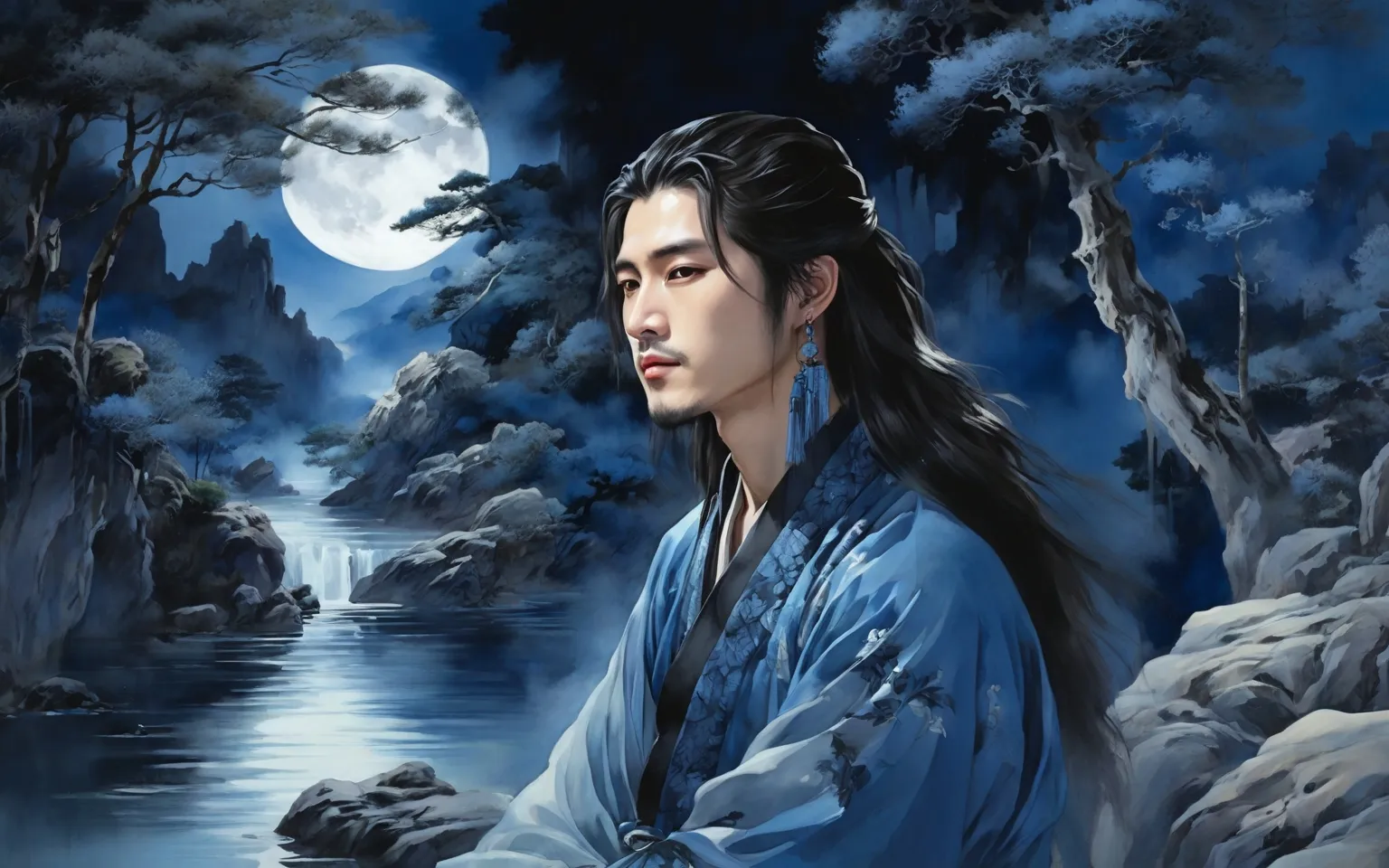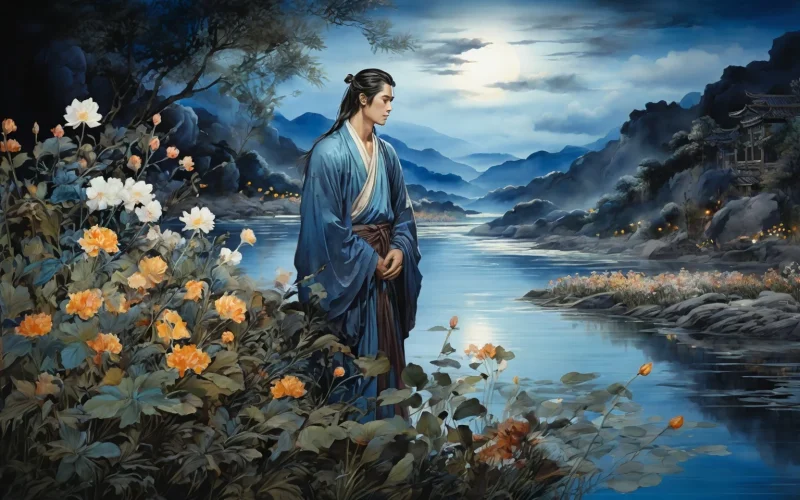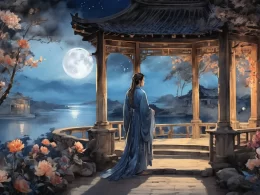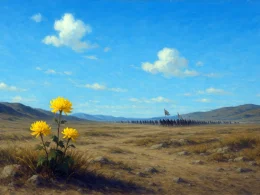Round a turn of the Qin Fortress winds the Wei River,
And Yellow Mountain foot-hills enclose the Court of China;
Past the South Gate willows comes the Car of Many Bells
On the upper Palace-Garden Road-a solid length of blossom;
A Forbidden City roof holds two phoenixes in cloud;
The foliage of spring shelters multitudes from rain;
And now, when the heavens are propitious for action,
Here is our Emperor ready-no wasteful wanderer.
Original Poem
「奉和圣制从蓬莱向兴庆阁道中留春雨中春望之作应制」
王维
渭水自萦秦塞曲,黄山旧绕汉宫斜。
銮舆迥出千门柳,阁道回看上苑花。
云里帝城双凤阙,雨中春树万人家。
为乘阳气行时令,不是宸游玩物华。
Interpretation
Composed during Emperor Xuanzong's Tianbao era while Wang Wei resided in Chang'an, this poem captures the capital's spring grandeur during an imperial procession. Viewed from elevated palace corridors, the Wei River, Mount Huang, imperial gardens and phoenix towers emerge through misty rain—a majestic tableau where natural splendor mirrors virtuous governance through subtle "praise-as-admonition" artistry.
First Couplet: "渭水自萦秦塞曲,黄山旧绕汉宫斜。"
Wèi shuǐ zì yíng qín sāi qǔ, huáng shān jiù rào hàn gōng xié.
"The Wei River curls round Qin frontier's trace; / Mount Huang still leans by Han palace's grace."
The panoramic opening frames Chang'an's northwestern landscape with historical depth. "Qin frontier" and "Han palace" imbue geography with cultural memory, establishing temporal layers beneath spring's vitality.
Second Couplet: "銮舆迥出千门柳,阁道回看上苑花。"
Luán yú jiǒng chū qiān mén liǔ, gé dào huí kàn shàng yuàn huā.
"Through thousand-gated willows the imperial coach proceeds; / From corridor heights, royal gardens' blooms one reads."
The perspective narrows to the emperor's movement—willow-lined processional gates and glimpsed garden flowers create kinetic pageantry. "Looking back" (回看) introduces reflective nuance amid ceremonial splendor.
Third Couplet: "云里帝城双凤阙,雨中春树万人家。"
Yún lǐ dì chéng shuāng fèng què, yǔ zhōng chūn shù wàn rén jiā.
"Twin phoenix towers pierce cloud-veiled skies; / Rain-drenched spring trees veil households' rise."
This stereoscopic view contrasts monumental architecture ("phoenix towers") with vibrant domesticity ("ten thousand homes"). The vertical "clouds-rain" axis and horizontal "towers-trees" plane construct an urban ecosystem where imperial and civilian spheres harmonize.
Fourth Couplet: "为乘阳气行时令,不是宸游玩物华。"
Wèi chéng yáng qì xíng shí lìng, bú shì chén yóu wán wù huá.
"To harness spring's vital force, rites unfold— / No mere imperial stroll to behold."
The conclusion elevates pageantry to statecraft, asserting the procession's purpose as cosmological alignment rather than leisure. Du Fu's deft praise contains subtle reminder of governance's higher calling.
Holistic Appreciation
The poem's gaze sweeps from distant landscapes to intimate urban details, synthesizing nature, history and ceremony into a vision of ideal governance. Through "clouds and rain" imagery, Du Fu balances imperial majesty ("phoenix towers") with civic vitality ("ten thousand homes"), suggesting harmonious interdependence between ruler and ruled. The final couplet's rhetorical pivot transforms visual splendor into political philosophy.
Artistic Merits
The poem's greatest artistic merit lies in its elevated perspective, three-dimensional composition, and profound allegorical depth. Viewing the imperial capital from the "elevated corridor," it captures stillness through movement and landscapes through gaze. The Wei River and Mount Huang, willows and blossoms, phoenix towers and spring trees—each pair embodies dynamic interplay of motion and stillness, near and far. Moreover, the concluding line "No mere imperial stroll to behold" masterfully transforms lyricism into encomium, exemplifying the Tang poetic tradition of "combining admonition with praise." Structurally, it features impeccable parallelism, natural rhythm, elegant diction, and a dignified yet mellow style.
Insights
Beyond documenting Tang grandeur, the poem models how art can ennoble political spectacle by connecting it to natural order and public welfare. Du Fu's technique—using spring's vitality as metaphor for benevolent governance—reminds us that true leadership harmonizes human systems with cosmic rhythms. The "view from above" becomes both aesthetic principle and political ideal.
Poem translator
Xu Yuanchong (许渊冲)
About the poet

Wang Wei (王维), 701 - 761 A.D., was a native of Yuncheng, Shanxi Province. Wang Wei was a poet of landscape and idylls. His poems of landscape and idylls, with far-reaching images and mysterious meanings, were widely loved by readers in later generations, but Wang Wei never really became a man of landscape and idylls.











